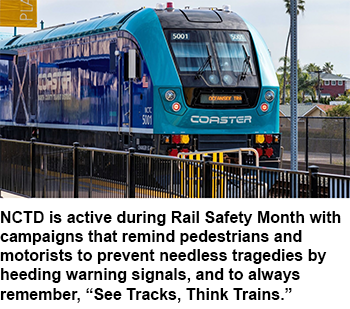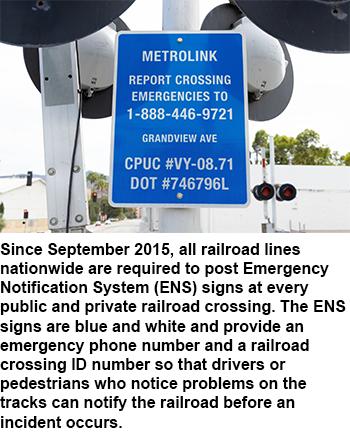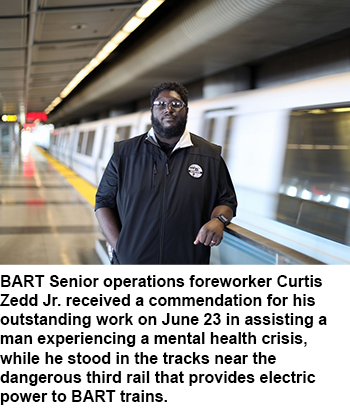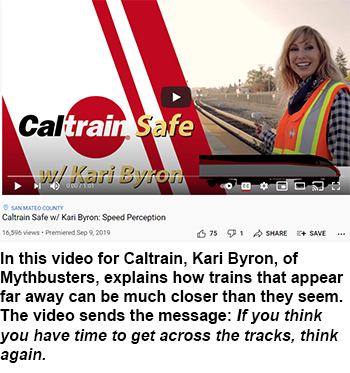September is Rail Safety & Suicide Prevention Month 
By Stephanie Jordan
Managing Editor
Transit California
California has the highest number of trespassing and grade crossing fatalities in the United States, reports California Operation Lifesaver, an independent non-profit safety education and awareness program dedicated to ending collisions, fatalities, and injuries at highway-rail grade crossings and on railroad rights of way in California.
In an effort to reduce these tragedies, state legislators passed a bill in 2009 that designated September as “Rail Safety Month.” Each year, passenger and freight rail operators team up to remind pedestrians and motorists to exercise caution when near tracks. Since that year, California Operation Lifesaver and its partner operators have observed the month with awareness and safety campaigns to educate the public about rail safety to help save lives.
In 2020, 245 trespassing incidents on railroad tracks in California ended with 115 injuries and 130 fatalities. Sadly, complacency around heavy commuter trains and relatively open access to the rails often leads to tragedy.
To highlight the importance of safety around train tracks and the high rate of intentional deaths on the rails, the Caltrain Board adopted a proclamation designating September as both Railroad Safety Month and Suicide Prevention Month. As part of Rail Safety Month, California Operation Lifesaver encourages everyone to wear red on any Friday in September and to take a photo or selfie to post on social media using the hashtag #RedOut4RailSafety. Here are two submissions for #RedOut4RailSafety, one from Capitol Corridor and the other from Sonoma-Marin Area Rail Transit (SMART).
“This proclamation for Railroad Safety & Suicide Prevention Month reaffirms Caltrain’s commitment to provide safe and efficient train service between San Francisco and Gilroy,” said Caltrain Board Chair Dev Davis at the time of the proclamation. “It is an opportunity to highlight the promotion and advancement of safety and prevention on the right of way through enhanced safety measures and increased public awareness.”
Studies have shown that separating train tracks from roads is the most effective way to prevent people from getting struck and killed by locomotives. Capitalizing on Rail Safety Month, on September 17, Caltrain hosted a ribbon-cutting event at its new Hillsdale Caltrain Station to celebrate the completion of, after four years of construction, the 25th Avenue Grade Separation Project in San Mateo. As part of the $205.9 million project improvements, the new station has an elevated center-boarding platform allowing for safer, more convenient pedestrian access to eliminate the risk of pedestrians and vehicles accessing the tracks, and prevents traffic bottlenecks at grade crossings. The project was funded by Measure A funds, contributions from the city of San Mateo, California Public Utilities Commission Section 190, and high-speed rail funds.
Signs
Since September 2015, all railroad lines nationwide are required to post Emergency Notification System (ENS) signs at every public and private railroad crossing. The Federal Railroad Administration established the requirement to make reporting problems and emergencies, such as suspicious activity on the tracks, stalled vehicles, or a warning device malfunction, easier to do.
The ENS signs are blue and white and provide an emergency phone number and a railroad crossing ID number so that drivers or pedestrians who notice problems on the tracks can notify the railroad before an incident occurs. The signs are near the crossings and visible to the first car stopped at a crossing when they look through their right passenger window. Every approach to a railroad crossing must have an ENS sign.
In recent years, railroads have been collaborating with suicide prevention agencies to prevent intentional deaths on the rails by posting crisis hotline signage at points all along the rails and partnering with local behavioral and mental health organizations.
This spring, Metrolink announced a $59,000 federal grant it received to fund an outreach campaign aimed at deterring people from committing suicide on its train tracks. The agency reports that suicides accounted for 40 percent of all incidents of trains striking pedestrians between 2017 and 2019. A contributing factor to suicides by train is the prevalence of homeless people living near the tracks. According to the agency, research shows that the availability of a means of death is a major factor in suicides.
“Metrolink is eager to work with law enforcement and community groups to help in any way we can to educate individuals at homeless encampments about options available to them,” said Metrolink CEO Stephanie Wiggins at the time of award. “This grant is a force multiplier for our efforts to keep people safe in the vicinity of our tracks.”
Compassion in Crisis
A San Francisco Bay Area Rapid Transit (BART) worker recently received a commendation for his efforts to help a man experiencing a mental health crisis. What follows is an account of the incident, as written by BART Senior Web Producer Melissa Jordan, in “Compassion in Crisis: BART Worker’s Quick Thinking, Empathy Help Save A Life.”
Curtis Zedd Jr., a born-and-bred Oaklander, does hard, physical work as a BART senior operations foreworker, troubleshooting problems on trains, his 6-foot-1 stature giving him a strong and commanding presence when emergencies arise. And yet, it was his empathetic, compassionate, sensitive side that kicked in recently when he was credited with saving the life of a man having a mental health crisis, for which he received a commendation for outstanding service.
It was June 23 and Zedd had just checked in to start a shift at Millbrae Station. He noticed that two station agents were trying to talk to a man who was standing in the trackway between the running rails (the tracks the train runs on) and the electrified third rail, which powers the train and can be deadly if touched. Zedd’s quick thinking kicked in and he got on the phone to the Operations Control Center, asking for the rail to the powered down, then he sat down on the edge of the platform, made direct eye contact with the man, and locked in his gaze.
“The first thing I said to him was, ‘Is everything OK?’ “ Zedd recalled. “And he said, ‘No, I’m just tired. I’m tired of everything,’ and I asked him to tell me about what was going on with him. He said he’d already told it, that he’d told his whole story. And I said, ‘Well, you haven’t told it to me. Tell me what’s going on.’”
The man, whom Zedd estimated to be in his late 50s, said he was a homeless veteran. He said he had nowhere to go, no hope, and just wanted “to end it all.”
“I told him that tomorrow would be another day. That he was able to wake up today, and now he would be able to wake up tomorrow and there would be another chance.”
“I just sat with him, and kept listening to his story,” Zedd said. “I told him, ‘This is not the way to go. We can get somebody out here to take you to a place to stay, to get you some help. I told him that he mattered, and also that his actions would affect a lot of people, people who would be hurt, who would be traumatized, by what he was trying to do.”
What’s especially remarkable is that Zedd stepped up even after having seen such traumatic situations already in his career. Many years ago, when he was working as a train operator at BART and just a few months out of training, a woman threw herself in front of his train at Montgomery Station; she survived. In another case a couple of years back on the Warm Springs line, he coaxed another person in crisis off the edge of the platform to safety.
Zedd doesn’t want to be called a hero, and said it was just instinct that kicked in. He went down into the trackway to be closer to the man at Millbrae after the third rail had been de-energized and trains were being held back.
“I told him, ‘Talk to me. You can vent. I’ll listen to whatever you have to say. Let’s just get out of the trackway. And in the end he calmed down.”
BART Police arrived soon and took the man to receive a mental health assessment.
“I’ve been in transit for 20 years, before BART at VTA, and unfortunately you see this in the rail industry, you see people at the end of their rope sometimes,” Zedd said. He has some close friends who were on site at the VTA yard the day of the recent mass shooting. He grieves for them, and for all who have been touched by such tragedies.
“These things affect a lot of us transportation workers,” he said. “It’s something that station agents deal with every day; they’re usually the first people to come into contact with anybody having a mental health crisis.”
“When we see people who are in trouble, who need help, we try to help them. We sympathize with them,” he said.
The job of a BART operations foreworker involves supervising train operators and station agents, in addition to troubleshooting and attending to emergencies. It’s an incredibly stressful job, but Zedd said he loves his work.
“When I clock in, for the 8, or 10, or 12 hours I’m here, I try to have a good attitude,” he said. “I come in and do my job to the best of my ability. We all have a lot of respect back and forth.”
Zedd calls himself a “transit junkie” who has been riding BART all of his 41 years. His earliest BART memory is taking the train as a young boy from Coliseum Station in Oakland to 12th Street/City Center Station for the Christmas parade.
Operations Control Center Manager Shanon Matthews, who put Zedd in for the commendation, said he truly went above and beyond the call of duty. “We got a call from Curtis to de-energize the rail,” she said. “This person was very erratic, and Curtis kept the individual engaged in conversation. He kept him distracted and got him to turn away from the third rail. And he actually talked the guy back up on the platform and calmed the guy down. He was a strong, compassionate presence.”
Unfortunately, last year’s tragic rail losses were not an anomaly. Reports North County Transit District (NCTD), in the last two calendar years, there were 467 tragic rail incidents (directly related to trespassing) recorded statewide of which 259 were fatal and 208 resulted in injury.
For its part, NCTD is active during Rail Safety Month reminding pedestrians and motorists to prevent needless tragedies by heeding warning signals and to always remember, “See Tracks, Think Trains.”
“Safety really is at the top of NCTD’s priority list. Education is one of the keys to keeping the public safe around the tracks,” said Tony Kranz, NCTD Board Chair, Encinitas Deputy Mayor. “The tracks are not somewhere to be playing, taking photos, or exercising. Tracks are only for trains.”